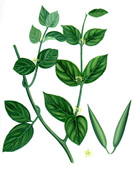| Latin Name | Gymnema sylvestre R.Br. (Asclepiadaceae) |
| Sanskrit Names | Meshashringi, Vishani, Madhunashini |
| Hindi Names | Gur-mar, Merasingi |
 History: This plant is called meshashringi, "ram’s horn" in Sanskrit. Its use in snake bite as a remedy was well known to the natives of the Konkan and as it appears from Ainslie, also to the natives of Southern India. A curious circumstance connected with this plant was first noticed by Mr. Edgeworth, namely, that if chewed it destroys the power of the tongue to appreciate the taste of sugar and all saccharine substances. This property of the leaves has been tested in 1887, carefully by Mr. D. Hooper. Distribution: Found in the Deccan Peninsula, extending to parts of northern and western India; occasionally cultivated as a medicinal plant. Habit: G.s. is a large, more or less pubescent, woody climber. The leaves are opposite, elliptic or ovate; flowers are small, yellow and in umbellate cymes; follicles are terete, lanceolate and up to 3 inches in length. Principle constituents: Gymnemic acid Indications: Gymnemic acid has anti-diabetic property. It has an inhibitory effect on plasma glucose and serum insulin in man. The plant is stomachic, stimulant, laxative and diuretic. The leaves of the plant, when chewed, possess the remarkable property of paralysing, for a few hours, the sense of taste for sweet and bitter substances; the taste for acid foods is not affected while the taste for salty foods is very slightly, if at all, influenced. Product range: Diabecon, Kilose |
|